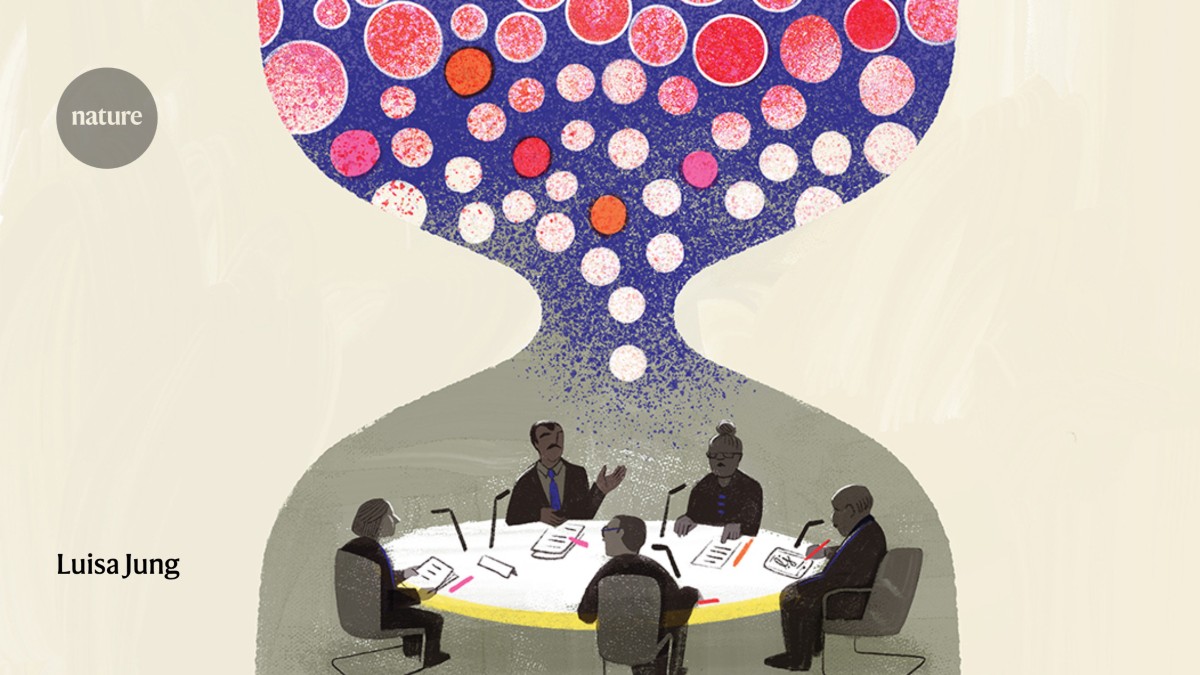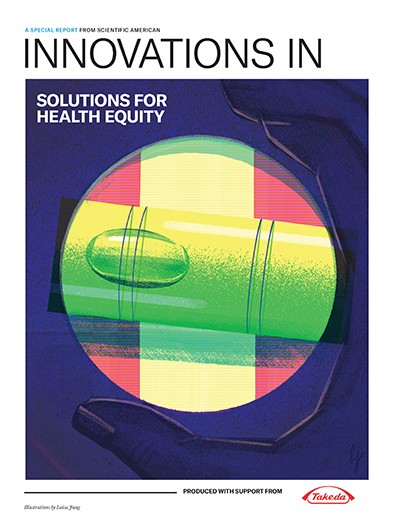The abandoned buildings behind the New Somerset hospital in Cape Town, South Africa, are prime real estate along the waterfront, so guards patrol the area day and night to protect against squatters. But squatters aren’t the only visitors. Tucked in among the empty facades is the Ivan Toms Center for Health, one of the first clinics in South Africa for men who have sex with men. It was launched in 2009 to provide comprehensive, free and sensitive health care. These days a new concern is on the minds of its visitors: mpox.
The first human case of mpox, formerly known as monkeypox, was described in the 1970s. The disease is thought to be caused by a virus that jumped from animals to humans and causes symptoms similar to smallpox. This past August the World Health Organization designated mpox a public health emergency of international concern for the second time in two years. Although the risk of mpox is not limited to men who have sex with men, the transmission dynamics of the 2022 outbreak led researchers and public health officials to identify them as a high-risk group. During 2022 more than 90 percent of known cases were among gay, bisexual, and other men who have sex with men. As the outbreak builds, Ivan Toms and similar clinics have seen an increase in patients wanting information.
Epidemics begin and end in communities. Today people around the world understand and respond to outbreaks differently than they did before the COVID pandemic. They appreciate concepts of transmission, protection and vaccine availability at a deeply personal level and are hungry for information. They want to know if a case has appeared locally and, if so, how to protect themselves. And the community most affected by mpox is one that has suffered multiple other outbreaks—most notably, the HIV/AIDS crisis. Critically, that means it’s a community that clinicians and public health researchers know, understand and collaborate with.
Innovations In Solutions For Health Equity
Dimie Ogoina, a Nigerian infectious disease physician-scientist, and his team were the first to describe sexual transmission of mpox in Nigeria in 2017. He believes that what makes the disease so challenging is the comorbidities that exist in Africa, especially co-infection with HIV. His team noticed that those with the most severe cases of mpox also had HIV infections. “Most of them had advanced HIV … and [were] not on treatment,” Ogoina says.
People with HIV accounted for around 40 percent of those diagnosed with mpox in the 2022 outbreak, and recent studies suggest that people who have more advanced HIV have worse clinical outcomes and higher mortality from mpox. How the two diseases interact is still a mystery, however. Researchers have yet to tease apart whether HIV infection raises the risk of acquiring mpox or increases its severity or whether people living with HIV simply might be more likely to be diagnosed because they’re already receiving better care. Better understanding this connection could be critically important. As the outbreak spreads to more nonendemic countries, effective treatment of HIV could hold one key to bringing the outbreak to an end.
Mpox’s present echoes HIV’s past—it’s a disease that has the potential to affect everyone and is more dangerous within a specific community. The comparison is etched in the brick and mortar of the clinic on the waterfront: Ivan Toms, the man, was both an anti-Apartheid and a gay rights activist.
The challenge with both diseases is how to get information to an already stigmatized group of people in a timely enough manner to halt the ongoing outbreak without making that stigma even worse. The 2022 outbreak showed that our first attempts failed: an article in PLOS Global Health was simply entitled “Monkeypox Is Not a Gay Disease,” recognizing that stigma had quickly emerged around the virus, echoing the early days of the HIV pandemic.
The advantage today is that those dealing with mpox have lessons from HIV/AIDS to follow. One small but meaningful way this has already been addressed is its name: monkeypox was renamed in 2022 to mitigate against racist and stigmatizing language. And as a result of the 2022 global emergency and lessons learned from the HIV/AIDS pandemic, public health officials are better equipped to build coordinated messaging and meet patients where they are.
“[Our] clients overall are now familiar with mpox, as we had the 2022 outbreak and did extensive education,” says Johan Hugo, an HIV clinician at the Ivan Toms Center. The center has integrated mpox services into its HIV care as recommended by the WHO and is part of a network of clinics and government agencies, including the South African Department of Health, that are using common messaging and strategies for mpox. “We work closely with organizations that support key populations to ensure we remain in line with one another,” he says. Such coordination in messaging helps to combat stigma around a disease that is not yet fully understood.
Despite significant improvements in access to HIV/AIDS treatment, gaps persist because patients are worried about their diagnosis creating stigma related to sexual and reproductive health. It is no different with mpox. The stigma associated with mpox can adversely affect prevention and treatment, with people less likely to disclose symptoms or seek care—they may even hide their condition for fear of being diagnosed. There is no specific treatment for mpox, and its symptoms are similar to those of other viruses such as chicken pox. But rapid, accurate diagnosis is the only way to prevent transmission and end outbreaks.
To achieve this, public health officials are taking everything they’ve learned from HIV and using it to attack mpox outbreaks. For instance, Ivan Toms and other clinics have developed approaches for delivering health services that allow for discretion and privacy. In addition to onsite testing and health checks, the center also packages and dispenses medications for its clients, eliminating the need to visit a general pharmacy. The approach has been so successful that after becoming the first clinic to run demonstration projects for HIV Pre-Exposure Prophylaxis (PrEP) in Africa in 2015, Ivan Toms is now one of the largest providers of PrEP in South Africa and a key training institution for service providers across 11 African countries.
PrEP reduces HIV risk by preventing HIV from entering the body and replicating. But protection requires that users maintain high levels of the medication in their bodies. Because adherence is crucial, practitioners aim for frictionless care that removes any social barriers. To that end, the clinic runs a WhatsApp service, smart lockers that safely store patients’ medicines, and mobile units that go directly into communities. Across the entire Cape Metro area, mobile units provide comprehensive HIV testing, treatment and prevention services, including self-screening, PrEP, antiretroviral drug initiation and follow-up, viral load testing, and screening for sexually transmitted infections. “Our mobile units are an extension of our facility and seek to provide the same level of care,” Hugo says. “Each of our teams provides comprehensive HIV testing, treatment and prevention.”
Because so many men who have acquired mpox are using PrEP, researchers think HIV may simply be another marker of higher-risk behaviors facilitating infection. The goal will be for mpox services to follow the same community outreach. “Our strategy for mpox currently is to provide broader information online and then to ensure that every client who comes through our services is provided direct information about the current situation,” Hugo says. Most days, that’s as many as 120 to 150 people.
There are two variants of mpox virus: clade I is endemic to central Africa and has killed up to 10 percent of the people it has infected during previous outbreaks, making it far deadlier than clade II, the type responsible for the 2022 outbreak. Both are circulating today in different countries in Africa. And unlike the 2022 outbreak, this one—which is tearing through the Democratic Republic of Congo (DRC)—has largely spread through men seeing women who are sex workers. “We are not dealing with one outbreak of one clade—we are dealing with several outbreaks of different clades in different countries with different modes of transmission and different levels of risk,” said Tedros Adhanom Ghebreyesus, WHO’s director general, during his opening remarks at the emergency committee meeting where the global health emergency was declared. “Stopping these outbreaks will require a tailored and comprehensive response, with communities at the center.”
In July 2024 South Africa notified the WHO of 20 confirmed mpox cases between May 8 and July 2, including three deaths—the first reported in the country since 2022. Cases occurred in three of South Africa’s nine provinces, including the Western Cape, where the Ivan Toms Center for Health resides. How the outbreak evolves from here will depend heavily on case identification and treatment management.
There is one internationally approved vaccine for mpox (another is approved in Japan with emergency approval in the DRC), which can act as both preexposure and postexposure prophylaxis for people at high risk. But although the vaccine is available in numerous high-income nations, current access in South Africa is limited to nonexistent. “The vaccine was originally made for smallpox, with U.S. funding,” says Mohga Kamal-Yanni, a senior policy adviser to the People’s Medicines Alliance, a global coalition with the goal of creating equitable access to vaccines and other medical technology. The companies that make these vaccines hold their patents, she says, “and when the mpox outbreak started, there was no discussion on technology transfer to another potential manufacturer.”
During the COVID pandemic, African countries surpassed all expectations despite challenges in vaccine access. Tanzania emerged as one of the best-performing African countries for COVID vaccination rates: Between January 2022 and April 2023 the country managed to bump its total population vaccination rate from 2.8 to 51 percent. This happened in part because COVID-specific vaccinations were integrated with other routine health services, allowing for effective delivery.
The COVID pandemic forever changed Africa’s policy, regulatory and vaccine landscapes. Low-income countries have learned to push through regulatory red tape, advocate for their people and work with high-income nations to get vaccines distributed more equitably. After putting a vaccination plan in place, Nigeria received the first donation of 10,000 vaccines from the U.S. just a few days after the global mpox emergency was declared. Other donations are aimed at countries across the African continent: Spain promised 500,000 doses from its stockpile, the U.S. committed to sending another 50,000 doses to the DRC, and Japan pledged millions of doses. Some of those vaccines have already arrived in Africa.
Citing lessons learned from COVID, global health institutions are also mobilizing resources. Gavi, the Vaccine Alliance, has mobilized resources for mpox, the rollout of which will be an early test of Gavi’s First Response Fund. The fund aims to make resources immediately available for a vaccine response to a public health emergency and includes a $500-million fund aimed at ensuring early access to vaccines within days of an emergency declaration. This, according to Gavi director of development finance David Kinder, was one of the big lessons learned from COVID.
The 2022 mpox outbreak was deemed to be over about nine months after the WHO declared an emergency. The 2024 outbreak could be larger and longer. If it is going to be extinguished as quickly, lessons learned from previous pandemics hold the key.



